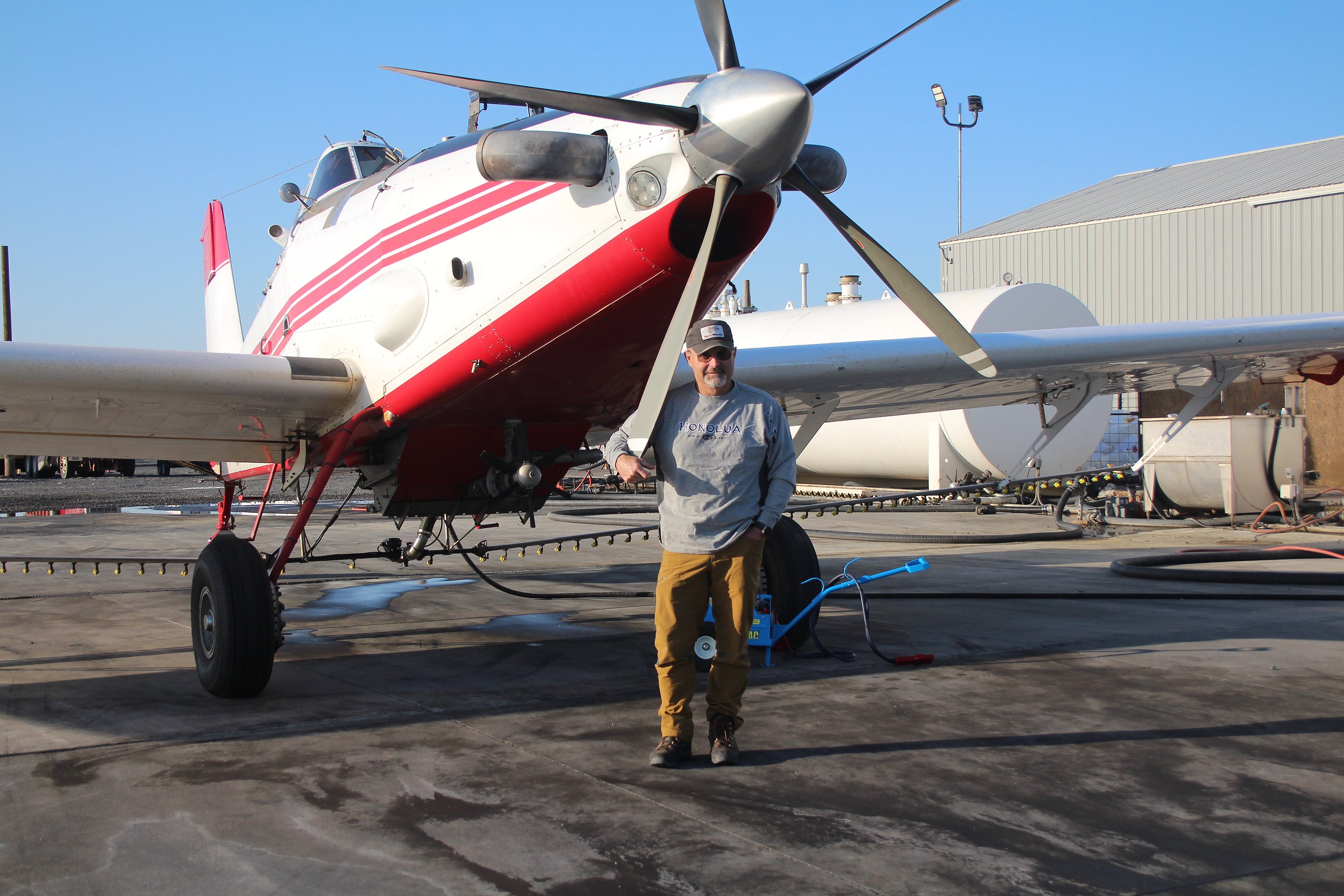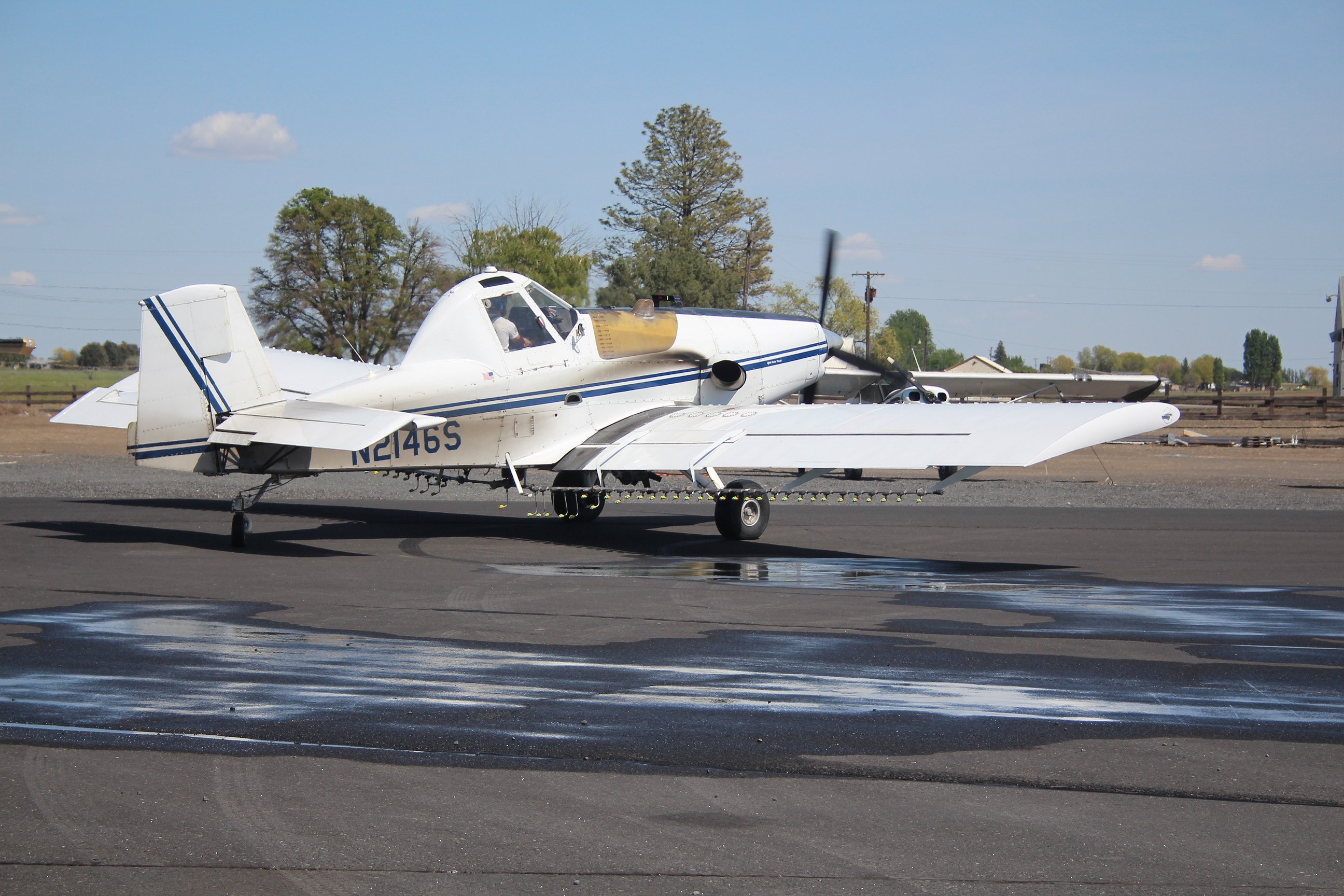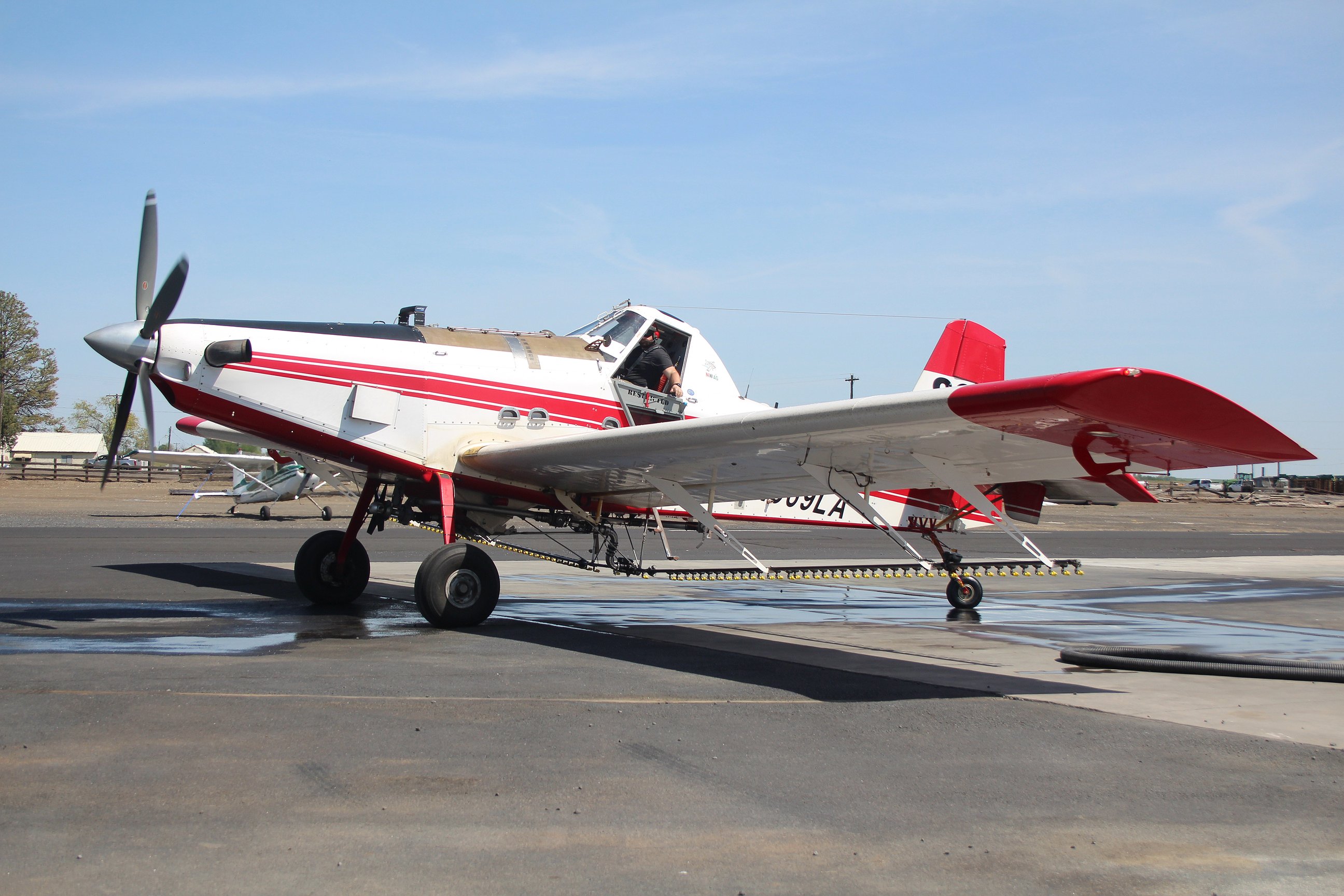Aerial application fun but challenging
MOSES LAKE — The science and craft of aerial application requires close and careful attention to detail. The flying is challenging, but, said Fred Meise, owner of Northwest Ag Service in Moses Lake, that’s one of many components that must be considered.
“We’re flying 150,160 miles an hour, three to 10 feet off the ground, with obstacles and power lines and circles – you’ve always got to pay attention to what’s around you, where the product is going and what it could affect downwind,” Meise said.
Meise has owned Northwest Ag Service for about 25 years, he said, and has been in the aerial application business for 35 years. He estimated Northwest Ag treats between 400,000 to 600,000 acres of farmland each year. Pilots can’t waste time and fuel flying back and forth to the main strip, so Meise said he has nine to 11 airfields dotted around his service area.
In some ways aerial application has changed, while in others it’s still pretty much the same business, he said. Many of the changes have been for the better; Miese cited the use of GPS to help pilots know where they are.
“They started with human flaggers. Then they had paper flags that they dropped off the wing. And about 20 years ago we went with GPS. It’s the best thing since sliced bread,” he said. “You can fly the field in different ways because of GPS.”
Improved engines are another change for the better.
“Airplanes in this day and age, we have a lot of horsepower,” he said. “It makes it easier to fly. Back in the day, when airplanes had marginal horsepower, you had to manage your airspeed. You had to be careful in them – you could back yourself into a corner and couldn’t get out. You still have to be careful, but we have a lot more horsepower.”
In other ways aerial application is still old-school flying.
“In the aviation world, it’s stick and rudder flying, meaning your eyes are outside all the time – you’re not flying instruments, you’re not flying an airliner,” he said. “This is stick and rudder flying. It’s fun flying.”
Fun flying, but a challenge. Meise’s son Weston is one of his pilots, and on a Thursday in mid-spring Weston Meise was flying a field near Northwest Ag’s main airfield on Road 7 Northwest. The field was on a slight hill bounded at one end by a road that, while not bumper to bumper, was busy with farm equipment and vehicle traffic.
Weston chose an uphill pattern, following the slope, shutting off the spray nozzles short of the end of the field, close enough so that the drift carried the chemicals over the irrigated section but not beyond. Impact past the field was minimal, if anything at all.
As every farmer knows, drift is bad irrespective of the method of application – chemicals in the wrong place can damage or kill crops. Meise said pilots have to pay especially close attention.
“We probably manage that the most. There’s always going to be drift – you’ve just got to manage it,” he said.
Wind, and wind direction, are important management tools. Meise cited the example of a field that required winds from the north.
“There are some jobs where you might have to wait three, four, five days for a north wind to finish the job,” he said.
Adapting conditions means aerial application is entirely weather-dependent.
“We can’t fly in 20-mile-an-hour winds,” Meise said. “There are a couple of reasons why. You want to do a good job. Second, the chemicals (applied), there’s usually a wind limit.”
Wind also factors into the considerations necessary when looking at surrounding fields.
“It depends on what’s downwind,” he said. “If we’re spraying commercial stuff, and (the neighboring farmer) has organic stuff, we have to have a wind away from it.”
Regulations governing organic certification are very stringent, Meise said, with limits for substances in the parts-per-million, or even parts-per-billion, range.
Meise said farmers use aerial application because of the fast response and to avoid damage to their fields.
“The biggest reason is timing. The farmer has an infestation, they can call us, and we can be on it in an hour and have it sprayed in an hour and a half. A ground rig or any other type of application, it’s hours before you can get to it. And too, with a ground rig you get tracks. With potatoes or onions, you’ve got to be careful because if you damage the potato or onion, that causes disease,” he said. “That’s why we do it by air.”
Of course, farmers don’t wait for signs of disease or infestation, and the speed of aerial application is helpful before there’s trouble.
“Most of the time what we’re spraying is to prevent an infestation. But if they do have a problem we’re the ones that they call because we’re kind of 911,” Meise said.
Aerial application is seasonal because agriculture is seasonal, he said, and that’s actually good because it’s a demanding business.
“It’s long days. We start a sunrise and we’re flying all day long,” he said.
Meise’s wife Darla is co-owner and sons Weston and Walter are part of the business; Meise said it being a family business is one thing that keeps him going. Walter is manager of the second Northwest Ag Services operation in Pasco.
But it’s tough to run a business from the cockpit of a plane, so he’s pretty sure this will be his last year flying, he said.
Meise grew up in Washtucna, he said, and always had a career in aviation in mind, specifically aerial application. It would be difficult to be flying 12 months of the year, he said, so the off-season is used for maintenance and other chores, and to decompress from the stresses of long days in the air.
It’s been a good career, he said.
“It’s fun flying, and we make a living,” he said.
Aerial Applicators Guide
Asotin County
Asotin County Conservation District
1397 Port Drive
Clarkston, WA 99403
509-552-8117
Leading Edge Aviation
8031 Veola Road
Clarkston, WA 99403
509-758-3000
Franklin County
B&R Aerial Crop Care, Inc.
409 Airport Lane
Connell, WA 99326
509-234-7791
Monday-Saturday 8 a.m.-5 p.m.
Pfister’s Farm Aviation Inc
2881 E. Sagemoor Road
Pasco, WA 99301
509-297-4304
Monday-Friday 9 a.m.- 6 p.m.
Garfield County
Outlaw Aviation
177 Pataha St.
Pomeroy, WA 99347
509-843-1057
Grant County
Northwest Ag Service
12509 Road 7 NE, Moses Lake
509-750-2309
Quincy Flying Services
19689 WA-28, Quincy
509-787-3223
Kittitas County
Ag Drones Northwest
305 E. First St., No. 84
Cle Elum, WA 98922
888-696-4581
agdronesnw.com
By appointment
Woodland Resource Services
1063 Emerson Road
Ellensburg, WA 98926
509-968-9675
Monday-Friday 8 a.m.-5 p.m.
Okanogan County
AgHawk Dynamics
P.O. Box 64
Manson, WA 98831
509-449-8989
By appointment only
Pend Oreille County
S & S Dusting Duo
18461 Westside Calispell Road
Cusick, WA 99119
509-445-4019
Spokane County
American Spray Service Inc – Dan Clark
14823 E. 14th Ave.
Spokane Valley, WA 99037
509-928-5670
Northwest Custom Farming
P.O. Box 30763
Spokane, WA 99223
509-443-9295
Twin Gardens
Spokane WA 99217
509-866-9424
Whitman County
McGuire Air Service
40023 State Route 27
Oakesdale, WA 99158
509-285-6131










